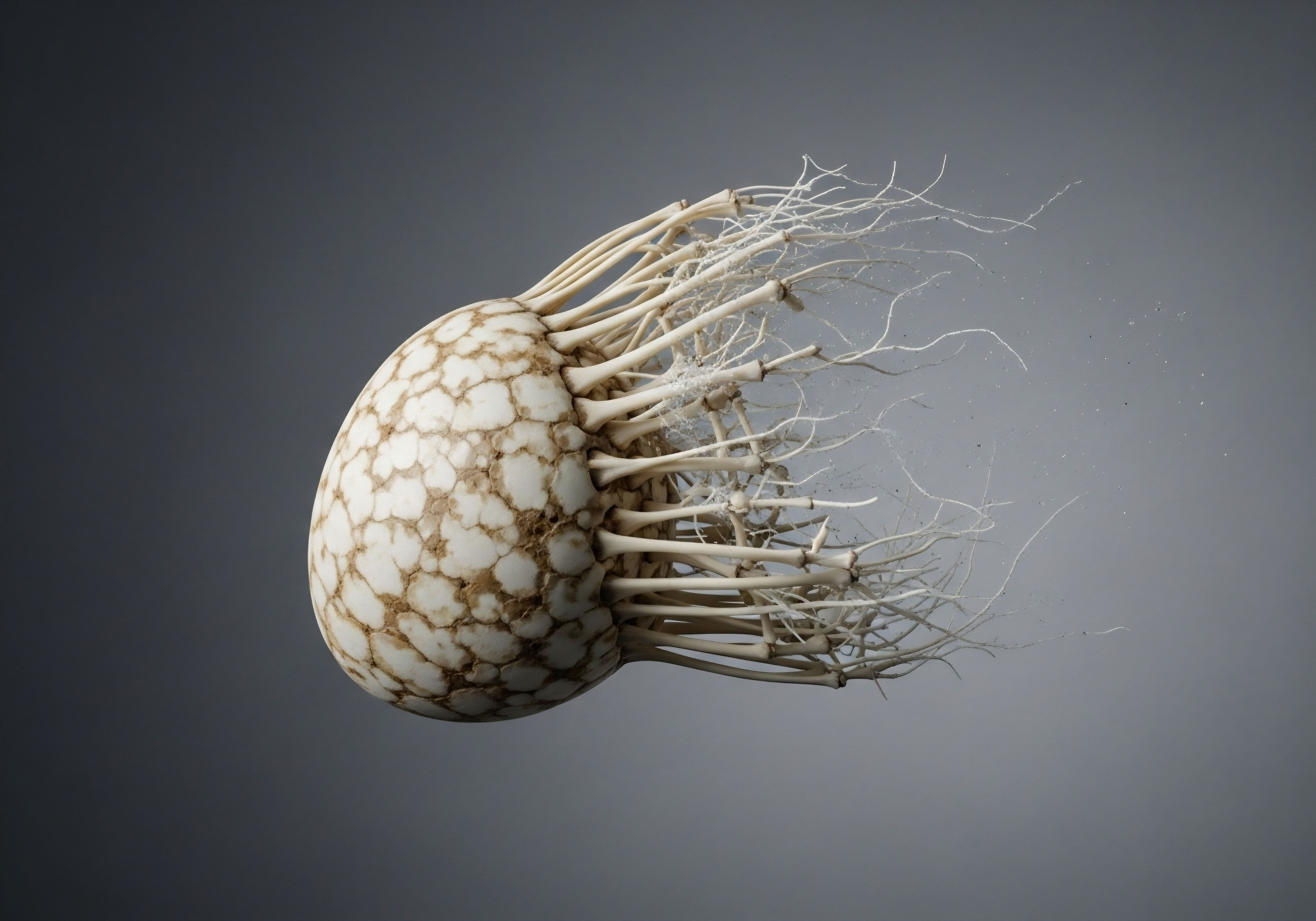

Fundamentals
The journey to understanding your body’s intricate systems begins with a single, validating truth your experience is real. The fatigue, the changes in mood, the sense of diminished vitality ∞ these are not abstract complaints. They are tangible signals from a biological system under strain.
When we discuss spermatogenesis, the process of creating new sperm, within the context of hypogonadism, we are addressing a specific physiological state. Hypogonadism signifies that the testes are not producing sufficient testosterone, the primary male androgen. This condition creates a foundational challenge for the entire reproductive apparatus.
Your body’s internal communication network, the Hypothalamic-Pituitary-Gonadal (HPG) axis, is already operating with a compromised signal. This axis is the command-and-control system for your reproductive health. The hypothalamus releases Gonadotropin-Releasing Hormone (GnRH), which signals the pituitary gland to release Luteinizing Hormone (LH) and Follicle-Stimulating Hormone (FSH).
LH tells the Leydig cells in the testes to produce testosterone, while FSH, along with testosterone, instructs the Sertoli cells to nurture and develop sperm. In a hypogonadal state, this finely tuned hormonal conversation is disrupted at one or more points. The signals may be too weak, the testicular response may be inadequate, or both.
This pre-existing condition makes the system exquisitely sensitive to external pressures. Lifestyle factors are powerful inputs that can either support this strained system or place an additional burden upon it. Think of your HPG axis as a communication line that already has static.
Lifestyle choices determine whether you clear up some of that static or add more disruptive noise. The process of spermatogenesis is metabolically expensive and requires a precise hormonal environment to proceed correctly. It is a 74-day cycle of cellular division and maturation that is highly vulnerable to disruption.
When testosterone levels are suboptimal, this process is already handicapped. The addition of negative lifestyle inputs can further degrade the environment within the seminiferous tubules, where sperm are born and mature. This is the critical intersection where your daily choices exert a profound influence on your reproductive potential. Understanding this connection is the first step in moving from a state of concern to a position of informed, proactive control over your own biological narrative.

The Architecture of Male Fertility
To fully appreciate how lifestyle factors exert their influence, we must first visualize the biological landscape. The male reproductive system is a masterpiece of endocrine engineering, centered on the HPG axis. This system functions as a continuous feedback loop. The hypothalamus acts as the central processor, monitoring circulating hormone levels.
When testosterone is low, it sends out GnRH. The pituitary, the master gland, responds by secreting LH and FSH. These hormones travel through the bloodstream to the testes, the production facility. Here, LH stimulates the Leydig cells, which are interspersed between the sperm-producing tubules, to synthesize testosterone.
Concurrently, FSH acts on the Sertoli cells, which are the “nurse” cells of the testes, located within the seminiferous tubules. The Sertoli cells form the blood-testis barrier, a protective wall that shields developing sperm from the rest of the body’s circulation and immune system. They provide the structural support and nourishment essential for spermatogenesis.
Testosterone, produced by the Leydig cells, performs two critical roles in this local environment. It acts directly on the Sertoli cells, synergizing with FSH to drive sperm production. It also diffuses into the general circulation to support all the other functions we associate with androgens, from muscle mass and bone density to libido and cognitive function.
The testosterone in the bloodstream is also what the hypothalamus “reads” to decide whether to send more GnRH signals. This elegant loop is designed to maintain hormonal equilibrium. In hypogonadism, this equilibrium is lost. The problem could be primary (the testes themselves are failing) or secondary (the hypothalamus or pituitary are failing to send the right signals). Regardless of the origin, the result is the same ∞ an insufficient testosterone supply to properly orchestrate testicular function.
A hypogonadal state creates a biological environment where the intricate process of sperm production is already compromised and thus more susceptible to disruption from external lifestyle pressures.

Why Is a Compromised System More Vulnerable?
A system operating at full capacity has reserves. It can handle stress, adapt to change, and buffer against occasional insults. A system that is already compromised, such as the HPG axis in a hypogonadal man, has lost much of that resilience. The cellular machinery is already working harder to achieve a suboptimal result.
Introducing additional stressors from lifestyle choices forces this strained system to divert its limited resources, further degrading its primary functions. For instance, the energy required to detoxify alcohol or manage the inflammatory cascade from a poor diet is energy that cannot be allocated to the meticulous process of sperm DNA replication and packaging.
The hormonal disruption caused by chronic stress or poor sleep adds another layer of dysfunctional signaling to an already confused system. Each negative lifestyle factor acts as a tax on an already overdrawn biological account. The consequence is a direct, measurable impact on the quality and quantity of sperm production.
The sperm count may decrease, motility may falter, and the rate of morphological defects may rise. These are the downstream effects of a system-wide burden that begins with lifestyle choices and ends in the delicate microenvironment of the testes.


Intermediate
Understanding that lifestyle choices impact a compromised HPG axis is the first step. The next is to examine the precise biological mechanisms through which these factors exert their influence. For a man with hypogonadism, whose system is already struggling to maintain androgen sufficiency, these external inputs are not minor variables.
They are potent modulators of endocrine function that can significantly amplify the underlying condition. Each choice ∞ what you eat, how you manage stress, the quality of your sleep ∞ translates into a cascade of biochemical signals that directly interface with the machinery of spermatogenesis. We will now dissect these pathways, revealing how specific lifestyle patterns can either further suppress testicular function or provide the support needed to optimize it within the constraints of a hypogonadal state.

Metabolic Load and Hormonal Disruption
The metabolic state of the body is inextricably linked to endocrine health. In the context of hypogonadism, two lifestyle-driven metabolic conditions are particularly damaging ∞ obesity and insulin resistance. These are not separate issues; they are deeply intertwined and create a vicious cycle that suppresses testicular function.

How Does Excess Adipose Tissue Disrupt Hormones?
Adipose tissue, or body fat, is an active endocrine organ. One of its primary functions is to produce the enzyme aromatase. This enzyme is responsible for the irreversible conversion of androgens (like testosterone) into estrogens (like estradiol). In a man with a healthy body composition, this process is a normal part of maintaining hormonal balance.
In a man with excess adipose tissue, particularly visceral fat around the organs, this process goes into overdrive. The increased mass of aromatase-producing tissue leads to an accelerated conversion of testosterone to estradiol. This has two devastating consequences for a hypogonadal man.
- Depletion of Testosterone ∞ His already limited supply of testosterone is being more rapidly converted into estrogen, lowering circulating testosterone levels even further.
- Increased Negative Feedback ∞ The HPG axis is highly sensitive to estrogen. Elevated estradiol levels send a powerful suppressive signal back to the hypothalamus and pituitary, telling them to reduce the output of GnRH and LH. This shuts down the body’s own drive to produce testosterone, worsening the hypogonadal state. This condition is often termed obesity-induced secondary hypogonadism.
This creates a self-perpetuating cycle ∞ low testosterone promotes fat gain, and increased fat gain further suppresses testosterone. For a man already diagnosed with hypogonadism, obesity acts as a powerful amplifier of his condition, directly undermining both systemic androgen levels and the local testicular environment required for spermatogenesis.

The Impact of Insulin Resistance on Testicular Cells
A diet high in refined carbohydrates and processed foods, combined with a sedentary lifestyle, frequently leads to insulin resistance. This is a state where the body’s cells become less responsive to the hormone insulin. To compensate, the pancreas produces more and more insulin, leading to hyperinsulinemia.
This chronic high level of insulin is profoundly disruptive to male reproductive health. Research has demonstrated a direct, negative correlation between insulin resistance and the function of the Leydig cells. While the precise mechanisms are still being fully elucidated, studies suggest that insulin resistance impairs the Leydig cells’ ability to respond to the LH signal from the pituitary.
Even if the LH signal is present, the testicular machinery responsible for producing testosterone is handicapped. Furthermore, the state of chronic inflammation that accompanies insulin resistance creates a hostile environment for the testes, increasing oxidative stress and potentially damaging both Leydig and Sertoli cells.
Excess body fat functions as an endocrine organ that actively converts testosterone to estrogen, while insulin resistance directly impairs the ability of testicular cells to produce testosterone.

The Stress Axis versus the Reproductive Axis
The body has two primary command-and-control axes ∞ the Hypothalamic-Pituitary-Gonadal (HPG) axis for reproduction and the Hypothalamic-Pituitary-Adrenal (HPA) axis for the stress response. These two systems have a deeply antagonistic relationship. When the HPA axis is chronically activated by psychological stress, work pressure, or poor sleep, it actively suppresses the HPG axis.
The mechanism is direct. When you perceive a threat, your hypothalamus releases Corticotropin-Releasing Hormone (CRH). This signals the pituitary to release Adrenocorticotropic Hormone (ACTH), which in turn tells the adrenal glands to flood the body with cortisol, the primary stress hormone.
High levels of cortisol have a direct inhibitory effect at every level of the reproductive cascade.
- At the Hypothalamus ∞ Cortisol suppresses the release of GnRH. This cuts the reproductive signal off at its source.
- At the Pituitary ∞ Cortisol makes the pituitary gland less sensitive to any GnRH that is released, reducing the secretion of LH and FSH.
- At the Testes ∞ Some evidence suggests cortisol may even have a direct suppressive effect on the Leydig cells, inhibiting testosterone production locally.
For a man with a robustly functioning HPG axis, the system can often rebound from acute stress. For a hypogonadal man, whose HPG axis is already weakened, chronic stress is a relentless suppressive force. It systematically dismantles the hormonal signaling required for spermatogenesis, creating an endocrine environment that is inhospitable to fertility.

Sleep Architecture and Hormonal Rhythm
Hormone production is not a steady-state process; it follows a distinct circadian rhythm. Testosterone production, in particular, is tightly linked to sleep architecture. The majority of a man’s daily testosterone is produced during sleep, with levels peaking in the early morning hours. This nocturnal pulse of LH from the pituitary, which drives testosterone production, is dependent on deep, restorative sleep.
Lifestyle factors that disrupt sleep, such as inconsistent bedtimes, exposure to blue light at night, excessive caffeine or alcohol, and unmanaged sleep apnea, flatten this crucial hormonal rhythm. Instead of a strong morning peak in testosterone, the level remains chronically low, day and night.
One study showed that just one week of sleeping only five hours per night decreased daytime testosterone levels by 10-15% in healthy young men. For a hypogonadal man, the impact is even more severe. His baseline is already low, and disrupting the one period of the day dedicated to hormonal replenishment can effectively eliminate any significant endogenous production, making the system entirely reliant on external support and further impairing the already struggling process of spermatogenesis.
| Lifestyle Factor | Primary Biological Mechanism | Effect on HPG Axis | Consequence for Spermatogenesis |
|---|---|---|---|
| Obesity / High Body Fat | Increased aromatase enzyme activity in adipose tissue. | Converts testosterone to estradiol; high estradiol suppresses GnRH and LH release. | Reduces available testosterone for Sertoli cells; worsens the hypogonadal state. |
| Poor Diet / Insulin Resistance | Hyperinsulinemia and chronic low-grade inflammation. | Impairs Leydig cell response to LH; increases systemic inflammation. | Decreases testosterone production; increases oxidative stress in the testes. |
| Chronic Psychological Stress | Sustained activation of the HPA axis and high cortisol levels. | Cortisol directly suppresses GnRH, LH, and FSH secretion. | Starves the testes of the necessary hormonal signals to initiate and sustain sperm production. |
| Poor Sleep Quality / Duration | Disruption of the nocturnal LH pulse and circadian rhythm. | Flattens the daily testosterone production peak. | Deprives the testes of the primary daily hormonal surge needed for optimal function. |
| Excessive Alcohol Intake | Direct testicular toxicity and increased oxidative stress. | Can lower testosterone and interfere with hormone metabolism in the liver. | Damages sperm DNA; impairs Leydig and Sertoli cell function directly. |


Academic
An advanced understanding of how lifestyle factors influence spermatogenesis in hypogonadal men requires a shift in perspective from organ-level endocrinology to cellular and molecular biology. The overarching mechanism connecting many of these lifestyle insults ∞ particularly diet and obesity ∞ is the induction of a state of chronic, low-grade systemic inflammation.
This inflammatory state, driven by metabolic dysfunction, creates a profoundly hostile microenvironment within the testes. The integrity of spermatogenesis depends on the near-perfect function of the Sertoli cells, which form the blood-testis barrier (BTB). This barrier creates an immunologically privileged site, protecting developing germ cells from the systemic circulation.
We will now explore the molecular pathway by which metabolic endotoxemia, a consequence of certain lifestyle choices, compromises the BTB, disrupts Leydig cell steroidogenesis, and ultimately sabotages sperm production in an already vulnerable hypogonadal system.

Metabolic Endotoxemia the Gut-Testis Inflammatory Axis
A diet high in saturated fats, processed foods, and refined sugars, characteristic of the “Western” dietary pattern, has been shown to alter the gut microbiome and increase intestinal permeability. This condition, often referred to as “leaky gut,” allows components of the outer membrane of gram-negative bacteria, known as lipopolysaccharides (LPS), to translocate from the gut lumen into the systemic circulation.
This phenomenon is termed metabolic endotoxemia. While not an acute infection, the persistent presence of low levels of LPS in the bloodstream acts as a powerful pro-inflammatory signal. LPS is a potent activator of the innate immune system, primarily through its interaction with Toll-like receptor 4 (TLR4), which is expressed on immune cells like macrophages and, critically, on somatic cells within the testes themselves, including both Leydig and Sertoli cells.
The activation of TLR4 initiates a downstream signaling cascade involving adapter proteins like MyD88 and the subsequent activation of the master inflammatory transcription factor, Nuclear Factor-kappa B (NF-κB). Activated NF-κB translocates to the nucleus and drives the transcription of a host of pro-inflammatory cytokines, including Tumor Necrosis Factor-alpha (TNF-α), Interleukin-6 (IL-6), and Interleukin-1β (IL-1β).
In a hypogonadal man, who may already have elevated inflammatory markers due to obesity-related secondary hypogonadism, this dietary-induced inflammatory signaling represents a significant additional burden.
Lipopolysaccharides from the gut can trigger a systemic inflammatory response that directly targets testicular cells, compromising the protective blood-testis barrier and inhibiting testosterone synthesis.

How Does Inflammation Compromise the Blood-Testis Barrier?
The BTB is not a static wall but a dynamic structure composed of complex tight junctions, ectoplasmic specializations, and gap junctions between adjacent Sertoli cells. The integrity of this barrier is paramount for successful spermatogenesis. The pro-inflammatory cytokines, particularly TNF-α and IL-6, have been shown to directly disrupt the BTB.
They achieve this by downregulating the expression and promoting the mislocalization of key tight junction proteins, such as claudin-11, occludin, and zonula occludens-1 (ZO-1). TNF-α can trigger the endocytosis of these junctional proteins, effectively dismantling the “mortar” that holds the Sertoli cell “bricks” together.
This increases the permeability of the BTB, allowing inflammatory mediators and immune cells to infiltrate the adluminal compartment of the seminiferous tubules, where the most sensitive stages of meiosis and spermiogenesis occur. This infiltration leads to germ cell apoptosis (programmed cell death) and a marked reduction in spermatogenic efficiency. For a system already lacking the strong trophic support of adequate testosterone, this breach of the protective barrier can be catastrophic.

Direct Inhibition of Leydig Cell Steroidogenesis
The inflammatory cascade also directly impairs testosterone production. Leydig cells express TLR4 and receptors for cytokines like TNF-α and IL-1β. The binding of LPS or these cytokines to Leydig cells triggers an intracellular inflammatory response that interferes with steroidogenesis at multiple enzymatic steps. Specifically, inflammatory signaling has been shown to suppress the expression and activity of key enzymes in the testosterone synthesis pathway, including:
- StAR (Steroidogenic Acute Regulatory Protein) ∞ Responsible for the critical rate-limiting step of transporting cholesterol from the outer to the inner mitochondrial membrane.
- P450scc (Cytochrome P450 side-chain cleavage enzyme) ∞ Converts cholesterol to pregnenolone.
- 3β-HSD (3β-hydroxysteroid dehydrogenase) ∞ Involved in the conversion of pregnenolone to progesterone.
- 17β-HSD (17β-hydroxysteroid dehydrogenase) ∞ Catalyzes the final step of converting androstenedione to testosterone.
This multi-point suppression means that even if a sufficient LH signal from the pituitary reaches the Leydig cell, the cell’s internal machinery to produce testosterone is crippled by inflammation. This provides a direct molecular link between a pro-inflammatory lifestyle (driven by diet, obesity, and even chronic stress) and the worsening of the hypogonadal state at the testicular level.
| Cellular Component | Key Proteins/Enzymes | Effect of Pro-Inflammatory Cytokines (TNF-α, IL-6) | Functional Consequence |
|---|---|---|---|
| Blood-Testis Barrier (Sertoli Cells) | Claudin-11, Occludin, ZO-1 | Downregulation of gene expression; promotion of protein endocytosis and mislocalization. | Increased BTB permeability; infiltration of immune cells; germ cell apoptosis. |
| Leydig Cell Steroidogenesis | StAR, P450scc, 3β-HSD, 17β-HSD | Suppression of gene expression and enzymatic activity. | Impaired cholesterol transport and testosterone synthesis; reduced testosterone output. |
| Spermatogenesis (Germ Cells) | DNA, mitochondria | Increased production of Reactive Oxygen Species (ROS) by inflammatory and somatic cells. | Increased sperm DNA fragmentation; impaired motility due to mitochondrial damage. |
This systems-level view demonstrates that lifestyle factors do not merely add a vague “stress” to the body. They initiate specific, deleterious molecular cascades. In the hypogonadal man, these cascades pour fuel on an existing fire, disrupting the protective testicular environment, actively inhibiting testosterone synthesis, and directly damaging developing sperm cells. Addressing these lifestyle factors, therefore, becomes a primary therapeutic intervention aimed at reducing the inflammatory load and restoring as much physiological function as possible to a compromised system.

References
- Pitteloud, Nelly, et al. “Increasing insulin resistance is associated with a decrease in Leydig cell testosterone secretion in men.” The Journal of Clinical Endocrinology & Metabolism, vol. 90, no. 5, 2005, pp. 2636-41.
- Sharpe, Richard M. “Environmental/lifestyle effects on spermatogenesis.” Philosophical Transactions of the Royal Society B ∞ Biological Sciences, vol. 365, no. 1546, 2010, pp. 1697-712.
- Kaur, H. & Bala, R. “Implications of lifestyle factors on male reproductive health.” Journal of Human Reproductive Sciences, vol. 14, no. 1, 2021, pp. 1-3.
- Rao, Shrilatha, et al. “Mechanisms of obesity-induced male infertility.” Expert Review of Endocrinology & Metabolism, vol. 5, no. 2, 2010, pp. 203-13.
- Choi, J. & I. S. Kim. “Effect of sleep deprivation on the male reproductive system in rats.” Journal of Korean Medical Science, vol. 28, no. 7, 2013, pp. 1076-80.
- Whirledge, S. & Cidlowski, J. A. “Glucocorticoids, stress, and reproduction.” Reviews in Endocrine and Metabolic Disorders, vol. 11, no. 2, 2010, pp. 109-19.
- Du Plessis, S. S. et al. “The effect of obesity on sperm disorders and male infertility.” Nature Reviews Urology, vol. 7, no. 3, 2010, pp. 153-61.
- Fui, Mark Ng Tang, et al. “Male obesity-related secondary hypogonadism ∞ pathophysiology, clinical implications and management.” European Endocrinology, vol. 15, no. 2, 2019, p. 83.
- Walczak-Jedrzejowska, R. et al. “Lifestyle, insulin resistance and semen quality as co-dependent factors of male infertility.” Journal of Clinical Medicine, vol. 11, no. 19, 2022, p. 5864.

Reflection
The information presented here maps the intricate biological pathways that connect your daily life to your cellular health. This knowledge is a tool. It shifts the perspective from one of passive suffering to one of active participation in your own wellness.
The diagnosis of hypogonadism is a data point; it is a description of your body’s current functional state. It is not a final verdict on your vitality. The critical question to carry forward from this discussion is a personal one ∞ What is the total load on my system?

Evaluating Your Personal System Load
Consider the inputs you provide your body each day. Think about the food you eat not just in terms of calories, but as metabolic information. Reflect on the quality of your sleep as the foundation for your body’s hormonal repair cycle. Acknowledge the physiological weight of chronic stress.
Each of these elements contributes to the overall burden your biological systems must manage. The journey toward optimizing your health within the context of your specific physiology begins with an honest inventory of these factors. Viewing your choices through this lens of “system load” can illuminate a clear path forward. The goal is to consciously and systematically reduce the static, allowing the inherent intelligence of your body’s endocrine system the best possible chance to find its equilibrium.



